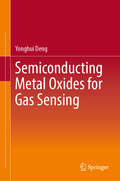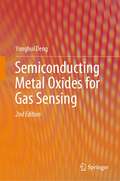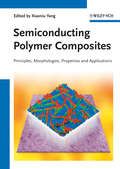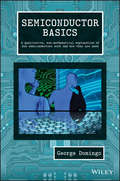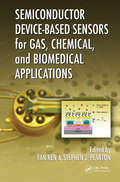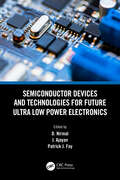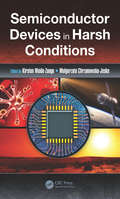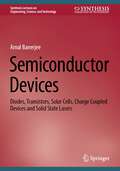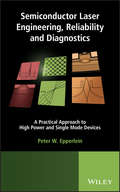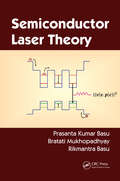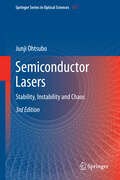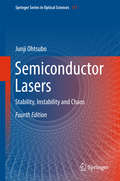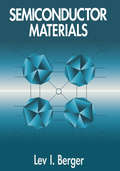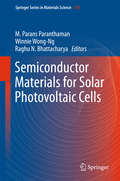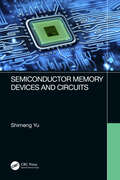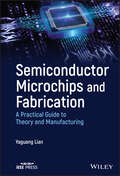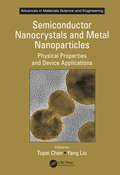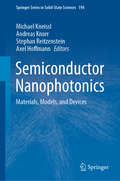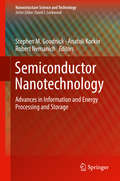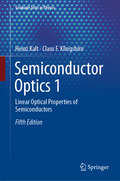- Table View
- List View
Semi-quantitative Approaches for Landslide Assessment and Prediction
by Sujit Mandal Ramkrishna MaitiIn the present authors attempted to have a clear insight into the interworking of geotectonic, geomorphic, hydrologic and anthropogenic factors leading to landslide in the Shiv khola Watershed, the most worst affected region of Darjiling Himalaya. This book includes the parameters responsible for landslide events in mountainous areas. It provides knowledge and understanding to the local people, planners, and policy makers about the causes and consequences of landslides as well as provides a suitable method to mitigate the landslips. The book deals with the role of land, water and soil in landslide phenomena. These three attributes have been described in terms of critical rainfall, critical slope, critical height and changes and development of drainage network in landslides. Mitigations and site-specific management options are evaluated considering the roles of local govt. , community and other organizations in both pre-slide and post-slide periods. Various scientific methods have been used to assess the landslides that will bring about tremendous help to researchers in the field. In particular, Researchers in Mountain Geomorphology and Geological and Geographical Society will get tremendous help from some topics such as 1-D slope stability model, SCS Curve Number Technique, Assessment of morphological parameters, application of RS & GIS, Application of Analytical Hierarchy Process. Semi-quantitative approach is followed for understanding spatial distribution of cohesion, friction angle slope, lithology and lineaments, drainage, upslope contributing area, land use and land cover types etc. This book also reveals some techniques and models for initiating slope instability.
Semiconducting Black Phosphorus: From 2D Nanomaterial to Emerging 3D Architecture (Emerging Materials and Technologies)
by Han Zhang Bing Wang Nasir Mahmood AbbasiBlack phosphorus (BP)-based two-dimensional (2D) nanomaterials are used as components in practical industrial applications in biomedicine, electronics, and photonics. There is a need to controllably shape engineered scalable structures of 2D BP building blocks, and their assembly/organization is desired for the formation of three-dimensional (3D) forms such as macro and hybrid architectures, as it is expected that these architectures will deliver even better materials performance in applications. Semiconducting Black Phosphorus: From 2D Nanomaterial to Emerging 3D Architecture provides an overview of the various synthetic strategies for 2D BP single-layer nanomaterials, their scalable synthesis, properties, and assemblies into 3D architecture. The book covers defect engineering and physical properties of black phosphorous; describes different strategies for the development of 2D nanostructures of BP with other species such as polymers, organic molecules, and other inorganic materials; offers a comparative study of 3D BP structures with other 3D architectures such as dichalcogenides (TMDs, graphene, and boron nitride); and discusses in detail applications of 3D macrostructures of BP in various fields such as energy, biomedical, and catalysis. This is an essential reference for researchers and advanced students in materials science and chemical, optoelectronic, and electrical engineering.
Semiconducting Metal Oxides for Gas Sensing
by Yonghui DengThis book focuses on the use of semiconducting metal oxides as gas sensing materials, including the sensing mechanism and sensing materials modification approach, while also providing a comprehensive introduction to semiconductor gas sensing devices. As an essential part of IoT (Internet of things), gas sensors have shown great significance and promising prospects. Therefore, studies on semiconducting metal oxides, one of the most important gas sensing materials, have increasingly attracted attention from various disciplines. The book offers a valuable reference guide to metal oxide gas sensing materials for undergraduate and graduate students alike. It will also benefit all researchers who investigate metal oxides nanomaterials synthesis and gas sensing with relevant frontier theories and concepts. Engineers working on research and development for semiconductor gas sensors will also find new ideas in sensor design.
Semiconducting Metal Oxides for Gas Sensing
by Yonghui DengThe second edition of this book focuses on the synthesis, design, and application of semiconducting metal oxides as gas sensing materials, including the gas sensing mechanism, and modification methods for sensing materials, while also providing a comprehensive introduction to semiconductor gas sensing devices. As an essential part of IoT (Internet of things), gas sensors have shown great significance and promising prospects. Therefore, studies on functional mesoporous metal oxides, one of the most important gas sensing materials based on their unique Knudsen diffusion behavior and tailored pore structure, have increasingly attracted attention from various disciplines. The book offers a valuable reference guide to metal oxide gas sensing materials for undergraduate and graduate students alike. It will also benefit all researchers who are involved in synthesis and gas sensing of metal oxides nanomaterials with relevant frontier theories and concepts. Engineers working on research and development of semiconductor gas sensors will also find some new ideas for sensor design.
Semiconducting Polymer Composites
by Xiaoniu YangPolymer composites made functional and customizable: new materials for real-life applications The academic and industrial interest in semiconducting polymer composites is rising, owing to the unique combination of easy and low-cost processability and versatility of these materialsThis comprehensive book provides broad coverage addressing the principles of semiconducting polymer blends such as morphology, energetics and processing as well as the wide range of applications in optics, electronics and optoelectronics.Fostering interdisciplinary research, the book combines the fields of polymer composites and functional polymers, allowing for cross-fertilization between these two scientific communities.
Semiconductor Advanced Packaging
by John H. LauThe book focuses on the design, materials, process, fabrication, and reliability of advanced semiconductor packaging components and systems. Both principles and engineering practice have been addressed, with more weight placed on engineering practice. This is achieved by providing in-depth study on a number of major topics such as system-in-package, fan-in wafer/panel-level chip-scale packages, fan-out wafer/panel-level packaging, 2D, 2.1D, 2.3D, 2.5D, and 3D IC integration, chiplets packaging, chip-to-wafer bonding, wafer-to-wafer bonding, hybrid bonding, and dielectric materials for high speed and frequency. The book can benefit researchers, engineers, and graduate students in fields of electrical engineering, mechanical engineering, materials sciences, and industry engineering, etc.
Semiconductor Basics: A Qualitative, Non-mathematical Explanation of How Semiconductors Work and How They are Used
by George DomingoAn accessible guide to how semiconductor electronics work and how they are manufactured, for professionals and interested readers with no electronics engineering background Semiconductor Basics is an accessible guide to how semiconductors work. It is written for readers without an electronic engineering background. Semiconductors are the basis for almost all modern electronic devices. The author—an expert on the topic—explores the fundamental concepts of what a semiconductor is, the different types in use, and how they are different from conductors and insulators. The book has a large number of helpful and illustrative drawings, photos, and figures. The author uses only simple arithmetic to help understand the device operation and applications. The book reviews the key devices that can be constructed using semiconductor materials such as diodes and transistors and all the large electronic systems based on these two component such as computers, memories, LCDs and related technology like Lasers LEDs and infrared detectors. The text also explores integrated circuits and explains how they are fabricated. The author concludes with some projections about what can be expected in the future. This important book: Offers an accessible guide to semiconductors using qualitative explanations and analogies, with minimal mathematics and equations Presents the material in a well-structured and logical format Explores topics from device physics fundamentals to transistor formation and fabrication and the operation of the circuits to build electronic devices and systems Includes information on practical applications of p-n junctions, transistors, and integrated circuits to link theory and practice Written for anyone interested in the technology, working in semiconductor labs or in the semiconductor industry, Semiconductor Basics offers clear explanations about how semiconductors work and its manufacturing process.
Semiconductor Device-Based Sensors for Gas, Chemical, and Biomedical Applications
by Stephen J. Pearton Fan RenThis book provides a basic understanding of new developments on semiconductor-based sensors. Written for senior undergraduate and graduate students majoring in solid-state physics, electrical engineering, and materials science and engineering, this material is also relevant to researchers in the field of sensors for gas, chemical, bio, and medical applications. It presents original theory and experimental research, featuring numerous experts in the field who review progress in semiconductor and nano-material-based sensors and discuss the latest research regarding their applications. Fields addressed include: Si-MOS based sensors, nano-material based sensors, GaN-bsed sensor arrays for nano- and pico-fluidic systems, and InN based sensors.
Semiconductor Devices and Technologies for Future Ultra Low Power Electronics
by D. Nirmal J. Ajayan Patrick J. FayThis book covers the fundamentals and significance of 2-D materials and related semiconductor transistor technologies for the next-generation ultra low power applications. It provides comprehensive coverage on advanced low power transistors such as NCFETs, FinFETs, TFETs, and flexible transistors for future ultra low power applications owing to their better subthreshold swing and scalability. In addition, the text examines the use of field-effect transistors for biosensing applications and covers design considerations and compact modeling of advanced low power transistors such as NCFETs, FinFETs, and TFETs. TCAD simulation examples are also provided. FEATURES Discusses the latest updates in the field of ultra low power semiconductor transistors Provides both experimental and analytical solutions for TFETs and NCFETs Presents synthesis and fabrication processes for FinFETs Reviews details on 2-D materials and 2-D transistors Explores the application of FETs for biosensing in the healthcare field This book is aimed at researchers, professionals, and graduate students in electrical engineering, electronics and communication engineering, electron devices, nanoelectronics and nanotechnology, microelectronics, and solid-state circuits.
Semiconductor Devices in Harsh Conditions (Devices, Circuits, and Systems)
by Kirsten Weide-Zaage, Malgorzata Chrzanowska-Jeske and Krzysztof IniewskiThis book introduces the reader to a number of challenges for the operation of electronic devices in various harsh environmental conditions. While some chapters focus on measuring and understanding the effects of these environments on electronic components, many also propose design solutions, whether in choice of material, innovative structures, or strategies for amelioration and repair. Many applications need electronics designed to operate in harsh environments. Readers will find, in this collection of topics, tools and ideas useful in their own pursuits and of interest to their intellectual curiosity. With a focus on radiation, operating conditions, sensor systems, package, and system design, the book is divided into three parts. The first part deals with sensing devices designed for operating in the presence of radiation, commercials of the shelf (COTS) products for space computing, and influences of single event upset. The second covers system and package design for harsh operating conditions. The third presents devices for biomedical applications under moisture and temperature loads in the frame of sensor systems and operating conditions.
Semiconductor Devices: Diodes, Transistors, Solar Cells, Charge Coupled Devices and Solid State Lasers (Synthesis Lectures on Engineering, Science, and Technology)
by Amal BanerjeeThis book examines in detail how a semiconductor device is designed and fabricated to satisfy best the requirements of the target application. The author presents and explains both basic and state-of-art semiconductor industry standards used in large/small signal equivalent circuit models for semiconductor devices that electronics engineers routinely use in their design calculations. The presentation includes detailed, step-by-step information on how a semiconductor device is fabricated, and the very sophisticated supporting technologies used in the process flow. The author also explains how standard laboratory equipment can be used to extract useful performance metrics of a semiconductor device.
Semiconductor Industry: Wafer Fab Exhaust Management
by J. Michael ShererGiven the myriad exhaust compounds and the corresponding problems that they can pose in an exhaust management system, the proper choice of such systems is a complex task. Presenting the fundamentals, technical details, and general solutions to real-world problems, Semiconductor Industry: Wafer Fab Exhaust Management offers practical guidance on selecting an appropriate system for a given application.Using examples that provide a clear understanding of the concepts discussed, Sherer covers facility layout, support facilities operations, and semiconductor process equipment, followed by exhaust types and challenges. He reviews exhaust point-of-use devices and exhaust line requirements needed between process equipment and the centralized exhaust system. The book includes information on wet scrubbers for a centralized acid exhaust system and a centralized ammonia exhaust system and on centralized equipment to control volatile organic compounds. It concludes with a chapter devoted to emergency releases and a separate chapter of examples illustrating these systems in use. Drawing on the author's 20 years of industry experience, the book shows you how to customize strategies specific to your needs, solve current problems, and prevent future issues in your exhaust management systems.
Semiconductor Laser Engineering, Reliability and Diagnostics
by Peter W. EpperleinThis reference book provides a fully integrated novel approach to the development of high-power, single-transverse mode, edge-emitting diode lasers by addressing the complementary topics of device engineering, reliability engineering and device diagnostics in the same book, and thus closes the gap in the current book literature. Diode laser fundamentals are discussed, followed by an elaborate discussion of problem-oriented design guidelines and techniques, and by a systematic treatment of the origins of laser degradation and a thorough exploration of the engineering means to enhance the optical strength of the laser. Stability criteria of critical laser characteristics and key laser robustness factors are discussed along with clear design considerations in the context of reliability engineering approaches and models, and typical programs for reliability tests and laser product qualifications. Novel, advanced diagnostic methods are reviewed to discuss, for the first time in detail in book literature, performance- and reliability-impacting factors such as temperature, stress and material instabilities. Further key features include: practical design guidelines that consider also reliability related effects, key laser robustness factors, basic laser fabrication and packaging issues; detailed discussion of diagnostic investigations of diode lasers, the fundamentals of the applied approaches and techniques, many of them pioneered by the author to be fit-for-purpose and novel in the application; systematic insight into laser degradation modes such as catastrophic optical damage, and a wide range of technologies to increase the optical strength of diode lasers; coverage of basic concepts and techniques of laser reliability engineering with details on a standard commercial high power laser reliability test program. Semiconductor Laser Engineering, Reliability and Diagnostics reflects the extensive expertise of the author in the diode laser field both as a top scientific researcher as well as a key developer of high-power highly reliable devices. With invaluable practical advice, this new reference book is suited to practising researchers in diode laser technologies, and to postgraduate engineering students. Dr. Peter W. Epperlein is Technology Consultant with his own semiconductor technology consulting business Pwe-PhotonicsElectronics-IssueResolution in the UK. He looks back at a thirty years career in cutting edge photonics and electronics industries with focus on emerging technologies, both in global and start-up companies, including IBM, Hewlett-Packard, Agilent Technologies, Philips/NXP, Essient Photonics and IBM/JDSU Laser Enterprise. He holds Pre-Dipl. (B.Sc.), Dipl. Phys. (M.Sc.) and Dr. rer. nat. (Ph.D.) degrees in physics, magna cum laude, from the University of Stuttgart, Germany. Dr. Epperlein is an internationally recognized expert in compound semiconductor and diode laser technologies. He has accomplished R&D in many device areas such as semiconductor lasers, LEDs, optical modulators, quantum well devices, resonant tunneling devices, FETs, and superconducting tunnel junctions and integrated circuits. His pioneering work on sophisticated diagnostic research has led to many world's first reports and has been adopted by other researchers in academia and industry. He authored more than seventy peer-reviewed journal papers, published more than ten invention disclosures in the IBM Technical Disclosure Bulletin, has served as reviewer of numerous proposals for publication in technical journals, and has won five IBM Research Division Awards. His key achievements include the design and fabrication of high-power, highly reliable, single mode diode lasers. Book Reviews "Semiconductor L P.W. Epperlein is a landmark in the recent literature on semiconductor lasers because it fills a longstanding gap between many excellent books on laser theory and the complex and challenging endeavor to fabricate these devices reproducibly and reliably in an industrial, real world environment. Having worked myself in the early resear...
Semiconductor Laser Fundamentals (Optical Science and Engineering)
by Toshiaki SuharaRanging from fundamental theoretical concepts to advanced device technologies, this reference/text explores the engineering, characteristics, and performance of specific semiconductor lasers. It defines key principles in electromagnetics, optoelectronics, and laser implementation for novel applications in optical communications, storage, processing
Semiconductor Laser Theory
by Prasanta Kumar Basu Bratati Mukhopadhyay Rikmantra BasuDeveloped from the authors' classroom-tested material, Semiconductor Laser Theory takes a semiclassical approach to teaching the principles, structure, and applications of semiconductor lasers. Designed for graduate students in physics, electrical engineering, and materials science, the text covers many recent developments, including diode lasers u
Semiconductor Lasers
by Junji OhtsuboThis third edition of "Semiconductor Lasers, Stability, Instability and Chaos" was significantly extended. In the previous edition, the dynamics and characteristics of chaos in semiconductor lasers after the introduction of the fundamental theory of laser chaos and chaotic dynamics induced by self-optical feedback and optical injection was discussed. Semiconductor lasers with new device structures, such as vertical-cavity surface-emitting lasers and broad-area semiconductor lasers, are interesting devices from the viewpoint of chaotic dynamics since they essentially involve chaotic dynamics even in their free-running oscillations. These topics are also treated with respect to the new developments in the current edition. Also the control of such instabilities and chaos control are critical issues for applications. Another interesting and important issue of semiconductor laser chaos in this third edition is chaos synchronization between two lasers and the application to optical secure communication. One of the new topics in this edition is fast physical number generation using chaotic semiconductor lasers for secure communication and development of chaos chips and their application. As other new important topics, the recent advance of new semiconductor laser structures is presented, such as quantum-dot semiconductor lasers, quantum-cascade semiconductor lasers, vertical-cavity surface-emitting lasers and physical random number generation with application to quantum key distribution. Stabilities, instabilities, and control of quantum-dot semiconductor lasers and quantum-cascade lasers are important topics in this field.
Semiconductor Lasers
by Junji OhtsuboThis third edition of "Semiconductor Lasers, Stability, Instability and Chaos" was significantly extended. In the previous edition, the dynamics and characteristics of chaos in semiconductor lasers after the introduction of the fundamental theory of laser chaos and chaotic dynamics induced by self-optical feedback and optical injection was discussed. Semiconductor lasers with new device structures, such as vertical-cavity surface-emitting lasers and broad-area semiconductor lasers, are interesting devices from the viewpoint of chaotic dynamics since they essentially involve chaotic dynamics even in their free-running oscillations. These topics are also treated with respect to the new developments in the current edition. Also the control of such instabilities and chaos control are critical issues for applications. Another interesting and important issue of semiconductor laser chaos in this third edition is chaos synchronization between two lasers and the application to optical secure communication. One of the new topics in this edition is fast physical number generation using chaotic semiconductor lasers for secure communication and development of chaos chips and their application. As other new important topics, the recent advance of new semiconductor laser structures is presented, such as quantum-dot semiconductor lasers, quantum-cascade semiconductor lasers, vertical-cavity surface-emitting lasers and physical random number generation with application to quantum key distribution. Stabilities, instabilities, and control of quantum-dot semiconductor lasers and quantum-cascade lasers are important topics in this field.
Semiconductor Materials
by Lev I. BergerSemiconductor Materials presents physico-chemical, electronic, electrical, elastic, mechanical, magnetic, optical, and other properties of a vast group of elemental, binary, and ternary inorganic semiconductors and their solid solutions. It also discusses the properties of organic semiconductors. Descriptions are given of the most commonly used semiconductor devices-charge-coupled devices, field-effect transistors, unijunction transistors, thyristors, Zener and avalanche diodes, and photodiodes and lasers. The current trend of transitioning from silicon technology to gallium arsenide technology in field-effect-based electronic devices is a special feature that is also covered. More than 300 figures and 100 tables highlight discussions in the text, and more than 2,000 references guide you to further sources on specific topics. Semiconductor Materials is a relatively compact book containing vast information on semiconductor material properties. Readers can compare results of the property measurements that have been reported by different authors and critically compare the data using the reference information contained in the book. Engineers who design and improve semiconductor devices, researchers in physics and chemistry, and students of materials science and electronics will find this a valuable guide.
Semiconductor Materials for Solar Photovoltaic Cells
by Raghu N. Bhattacharya M. Parans Paranthaman Winnie Wong-NgThis book reviews the current status of semiconductor materials for conversion of sunlight to electricity, and highlights advances in both basic science and manufacturing. Photovoltaic (PV) solar electric technology will be a significant contributor to world energy supplies when reliable, efficient PV power products are manufactured in large volumes at low cost. Expert chapters cover the full range of semiconductor materials for solar-to-electricity conversion, from crystalline silicon and amorphous silicon to cadmium telluride, copper indium gallium sulfide selenides, dye sensitized solar cells, organic solar cells, and environmentally friendly copper zinc tin sulfide selenides. The latest methods for synthesis and characterization of solar cell materials are described, together with techniques for measuring solar cell efficiency. Semiconductor Materials for Solar Photovoltaic Cells presents the current state of the art as well as key details about future strategies to increase the efficiency and reduce costs, with particular focus on how to reduce the gap between laboratory scale efficiency and commercial module efficiency. This book will aid materials scientists and engineers in identifying research priorities to fulfill energy needs, and will also enable researchers to understand novel semiconductor materials that are emerging in the solar market. This integrated approach also gives science and engineering students a sense of the excitement and relevance of materials science in the development of novel semiconductor materials. · Provides a comprehensive introduction to solar PV cell materials · Reviews current and future status of solar cells with respect to cost and efficiency · Covers the full range of solar cell materials, from silicon and thin films to dye sensitized and organic solar cells · Offers an in-depth account of the semiconductor material strategies and directions for further research · Features detailed tables on the world leaders in efficiency demonstrations · Edited by scientists with experience in both research and industry
Semiconductor Memory Devices and Circuits
by Shimeng YuThis book covers semiconductor memory technologies from device bit-cell structures to memory array design with an emphasis on recent industry scaling trends and cutting-edge technologies. The first part of the book discusses the mainstream semiconductor memory technologies. The second part of the book discusses the emerging memory candidates that may have the potential to change the memory hierarchy, and surveys new applications of memory technologies for machine/deep learning applications. This book is intended for graduate students in electrical and computer engineering programs and researchers or industry professionals in semiconductors and microelectronics. Explains the design of basic memory bit-cells including 6-transistor SRAM, 1-transistor-1-capacitor DRAM, and floating gate/charge trap FLASH transistor Examines the design of the peripheral circuits including the sense amplifier and array-level organization for the memory array Examines industry trends of memory technologies such as FinFET based SRAM, High-Bandwidth-Memory (HBM), 3D NAND Flash, and 3D X-point array Discusses the prospects and challenges of emerging memory technologies such as PCM, RRAM, STT-MRAM/SOT-MRAM and FeRAM/FeFET Explores the new applications such as in-memory computing for AI hardware acceleration.
Semiconductor Microchips and Fabrication: A Practical Guide to Theory and Manufacturing
by Yaguang LianSemiconductor Microchips and Fabrication Advanced and highly illustrated guide to semiconductor manufacturing from an experienced industry insider Semiconductor Microchips and Fabrication is a practical yet advanced book on the theory, design, and manufacturing of semiconductor microchips that describes the process using the principles of physics and chemistry, fills in the knowledge gaps for professionals and students who need to know how manufacturing equipment works, and provides valuable suggestions and solutions to many problems that students or engineers often encounter in semiconductor processing, including useful experiment results to help in process work. The explanation of the semiconductor manufacturing process, and the equipment needed, is carried out based on the machines that are used in clean rooms over the world so readers understand how they can use the equipment to achieve their design and manufacturing ambitions. Combining theory with practice, all descriptions are carried out around the actual equipment and processes by way of a highly visual text, with illustrations including equipment pictures, manufacturing process schematics, and structures of semiconductor microchips. Sample topics covered in Semiconductor Microchips and Fabrication include: An introduction to basic concepts, such as impedance mismatch from plasma machines and theories, such as energy bands and Clausius-Clapeyron equation Basic knowledge used in semiconductor devices and manufacturing machines, including DC and AC circuits, electric fields, magnetic fields, resonant cavity, and the components used in the devices and machines Transistor and integrated circuits, including bipolar transistors, junction field effect transistors, and metal-semiconductor field effect transistors The main processes used in the manufacturing of microchips, including lithography, metallization, reactive-ion etching (RIE), plasma-enhanced chemical vapor deposition (PECVD), thermal oxidation and implantation, and more The skills in the design and problem solving of processes, such as how to design a dry etching recipe, and how to solve the micro-grass problems in Bosch process Through Semiconductor Microchips and Fabrication, readers can obtain the fundamental knowledge and skills of semiconductor manufacturing, which will help them better understand and use semiconductor technology to improve their product quality or project research. Before approaching this text, readers should have basic knowledge of physics, chemistry, and circuitry.
Semiconductor Nanocrystals and Metal Nanoparticles: Physical Properties and Device Applications (Advances in Materials Science and Engineering)
by Tupei Chen and Yang LiuSemiconductor nanocrystals and metal nanoparticles are the building blocks of the next generation of electronic, optoelectronic, and photonic devices. Covering this rapidly developing and interdisciplinary field, the book examines in detail the physical properties and device applications of semiconductor nanocrystals and metal nanoparticles. It begins with a review of the synthesis and characterization of various semiconductor nanocrystals and metal nanoparticles and goes on to discuss in detail their optical, light emission, and electrical properties. It then illustrates some exciting applications of nanoelectronic devices (memristors and single-electron devices) and optoelectronic devices (UV detectors, quantum dot lasers, and solar cells), as well as other applications (gas sensors and metallic nanopastes for power electronics packaging). Focuses on a new class of materials that exhibit fascinating physical properties and have many exciting device applications. Presents an overview of synthesis strategies and characterization techniques for various semiconductor nanocrystal and metal nanoparticles. Examines in detail the optical/optoelectronic properties, light emission properties, and electrical properties of semiconductor nanocrystals and metal nanoparticles. Reviews applications in nanoelectronic devices, optoelectronic devices, and photonic devices.
Semiconductor Nanophotonics: Materials, Models, and Devices (Springer Series in Solid-State Sciences #194)
by Andreas Knorr Michael Kneissl Axel Hoffmann Stephan ReitzensteinThis book provides a comprehensive overview of the state-of-the-art in the development of semiconductor nanostructures and nanophotonic devices. It covers epitaxial growth processes for GaAs- and GaN-based quantum dots and quantum wells, describes the fundamental optical, electronic, and vibronic properties of nanomaterials, and addresses the design and realization of various nanophotonic devices. These include energy-efficient and high-speed vertical cavity surface emitting lasers (VCSELs) and ultra-small metal-cavity nano-lasers for applications in multi-terabus systems; silicon photonic I/O engines based on the hybrid integration of VCSELs for highly efficient chip-to-chip communication; electrically driven quantum key systems based on q-bit and entangled photon emitters and their implementation in real information networks; and AlGaN-based deep UV laser diodes for applications in medical diagnostics, gas sensing, spectroscopy, and 3D printing. The experimental results are accompanied by reviews of theoretical models that describe nanophotonic devices and their base materials. The book details how optical transitions in the active materials, such as semiconductor quantum dots and quantum wells, can be described using a quantum approach to the dynamics of solid-state electrons under quantum confinement and their interaction with phonons, as well as their external pumping by electrical currents. With its broad and detailed scope, this book is indeed a cutting-edge resource for researchers, engineers and graduate-level students in the area of semiconductor materials, optoelectronic devices and photonic systems.
Semiconductor Nanotechnology: Advances in Information and Energy Processing and Storage (Nanostructure Science and Technology)
by Stephen M. Goodnick Anatoli Korkin Robert NemanichThis book presents research dedicated to solving scientific and technological problems in many areas of electronics, photonics and renewable energy. Energy and information are interconnected and are essential elements for the development of human society. Transmission, processing and storage of information requires energy consumption, while the efficient use and access to new energy sources requires new information (ideas and expertise) and the design of novel systems such as photovoltaic devices, fuel cells and batteries. Semiconductor physics creates the knowledge base for the development of information (computers, cell phones, etc.) and energy (photovoltaic) technologies. The exchange of ideas and expertise between these two technologies is critical and expands beyond semiconductors. Continued progress in information and renewable energy technologies requires miniaturization of devices and reduction of costs, energy and material consumption. The latest generation of electronic devices is now approaching nanometer scale dimensions, new materials are being introduced into electronics manufacturing at an unprecedented rate, and alternative technologies to mainstream CMOS are evolving. Nanotechnology is widely accepted as a source of potential solutions in securing future progress for information and energy technologies.Semiconductor Nanotechnology features chapters that cover the following areas: atomic scale materials design, bio- and molecular electronics, high frequency electronics, fabrication of nanodevices, magnetic materials and spintronics, materials and processes for integrated and subwave optoelectronics, nanoCMOS, new materials for FETs and other devices, nanoelectronics system architecture, nano optics and lasers, non-silicon materials and devices, chemical and biosensors, quantum effects in devices, nano science and technology applications in the development of novel solar energy devices, and fuel cells and batteries.
Semiconductor Optics 1: Linear Optical Properties of Semiconductors (Graduate Texts in Physics)
by Heinz Kalt Claus F. KlingshirnThis revised and updated edition of the well-received book by C. Klingshirn provides an introduction to and an overview of all aspects of semiconductor optics, from IR to visible and UV. It has been split into two volumes and rearranged to offer a clearer structure of the course content. Inserts on important experimental techniques as well as sections on topical research have been added to support research-oriented teaching and learning. Volume 1 provides an introduction to the linear optical properties of semiconductors. The mathematical treatment has been kept as elementary as possible to allow an intuitive approach to the understanding of results of semiconductor spectroscopy. Building on the phenomenological model of the Lorentz oscillator, the book describes the interaction of light with fundamental optical excitations in semiconductors (phonons, free carriers, excitons). It also offers a broad review of seminal research results augmented by concise descriptions of the relevant experimental techniques, e.g., Fourier transform IR spectroscopy, ellipsometry, modulation spectroscopy and spatially resolved methods, to name a few. Further, it picks up on hot topics in current research, like quantum structures, mono-layer semiconductors or Perovskites. The experimental aspects of semiconductor optics are complemented by an in-depth discussion of group theory in solid-state optics. Covering subjects ranging from physics to materials science and optoelectronics, this book provides a lively and comprehensive introduction to semiconductor optics. With over 120 problems, more than 480 figures, abstracts to each chapter, as well as boxed inserts and a detailed index, it is intended for use in graduate courses in physics and neighboring sciences like material science and electrical engineering. It is also a valuable reference resource for doctoral and advanced researchers.


